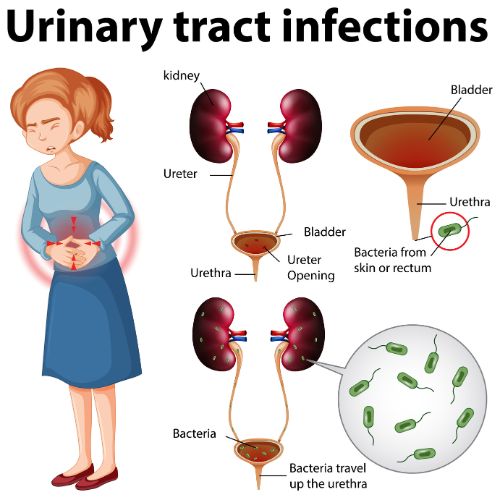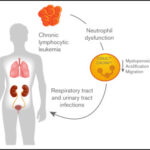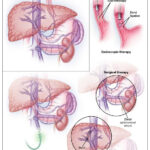Bacterial urinary tract infections (UTIs) are among the most prevalent infections globally, with a disproportionate burden on women, the elderly, and individuals with underlying urological abnormalities. Preventive strategies are essential to reduce recurrence, antimicrobial resistance, and healthcare costs.

Understanding the Causes and Risk Factors of Bacterial UTIs
Urinary tract infections arise primarily due to the ascension of uropathogenic bacteria, most commonly Escherichia coli, into the urethra and bladder.
Primary Causes
- Colonization of uropathogens from the gastrointestinal tract
- Disruption of urinary flow
- Poor perineal hygiene
- Frequent sexual activity
- Incomplete bladder emptying
Key Risk Factors
| Demographic | Risk Factors |
|---|---|
| Women | Shorter urethra, sexual intercourse, postmenopausal estrogen decline |
| Elderly | Bladder prolapse, incontinence, catheter use |
| Men | Prostate enlargement, catheterization |
| Children | Vesicoureteral reflux, toilet training issues |
| General | Dehydration, diabetes, immunosuppression |
Daily Hygiene Habits to Prevent UTI
Adhering to rigorous hygiene practices plays a critical role in reducing bacterial transmission to the urinary tract.
Best Practices
- Wipe from front to back after urination and defecation to prevent fecal contamination.
- Urinate before and after intercourse to flush out introduced bacteria.
- Avoid douching or using scented feminine products, which disrupt natural flora.
- Opt for breathable cotton underwear and change undergarments daily.
- Shower instead of using bathtubs in individuals prone to UTIs.
Menstrual Hygiene Considerations
- Change sanitary pads or tampons every 4–6 hours.
- Prefer pads over tampons to minimize internal bacterial growth.
Hydration and Dietary Approaches to UTI Prevention
Proper hydration and dietary choices can help dilute urine, reduce bacterial adherence, and support immune health.
Hydration Guidelines
- Consume at least 2 to 2.5 liters of water daily, unless contraindicated.
- Monitor for pale-yellow urine as an indicator of adequate hydration.
Recommended Foods
| Category | Examples | UTI Benefit |
|---|---|---|
| Probiotics | Yogurt, kefir | Supports vaginal and gut flora balance |
| Cranberries | Juice, capsules | Contains proanthocyanidins to inhibit E. coli adhesion |
| Vitamin C-rich foods | Oranges, strawberries | Acidifies urine, reducing bacterial survival |
| High-fiber diet | Whole grains, leafy greens | Promotes bowel regularity to reduce perineal contamination |
Avoid caffeine, alcohol, and spicy foods during active or recurrent infections as they may irritate the bladder.
Medical and Pharmacologic Prevention of UTIs
For patients experiencing frequent recurrences, medical intervention may be warranted to maintain urinary tract health.
Antimicrobial Prophylaxis
| Indication | Medication | Dosing |
|---|---|---|
| Recurrent UTIs (≥3/year) | Nitrofurantoin, TMP-SMX | Once daily at bedtime |
| Post-coital UTI | Single dose Nitrofurantoin | Within 2 hours post-intercourse |
| Non-antibiotic prophylaxis | Methenamine hippurate | 1g twice daily |
Antibiotic use must be judicious to avoid resistance. Urine cultures guide appropriate agent selection.
Estrogen Therapy in Postmenopausal Women
Topical vaginal estrogen can restore mucosal integrity and promote lactobacilli colonization, lowering the risk of recurrent UTIs.
Urinary Catheter Management and UTI Prevention
Catheter-associated urinary tract infections (CAUTIs) account for a significant proportion of healthcare-acquired infections.
Prevention Protocols
- Use catheters only when medically necessary.
- Employ aseptic insertion techniques and closed drainage systems.
- Daily catheter care with mild soap and water.
- Remove catheters as early as possible.
Healthcare providers must be vigilant about catheter necessity and monitor for signs of infection.
Behavioral Modifications and Lifestyle Adjustments
Lifestyle changes can substantially reduce UTI incidence, especially in high-risk populations.
Effective Lifestyle Changes
- Avoid prolonged holding of urine; void every 3–4 hours.
- Address constipation aggressively with dietary and medical measures.
- Maintain adequate sexual health hygiene, including use of condoms and urination post-intercourse.
- Manage chronic conditions like diabetes with strict glycemic control.
- Stop smoking to reduce bladder mucosal irritation.
Preventing UTI in Specific Populations
Children
- Encourage regular toileting schedules
- Teach correct wiping technique
- Increase fluid intake
- Address any signs of dysfunctional voiding early
Pregnant Women
- Regular urine screenings during prenatal care
- Prompt treatment of asymptomatic bacteriuria
- Safe hydration and hygiene education
Elderly
- Evaluate for post-void residuals and incomplete emptying
- Avoid long-term catheter use
- Monitor for atypical symptoms (e.g., confusion or agitation)
Preventing bacterial urinary tract infections necessitates a holistic approach involving personal hygiene, adequate hydration, targeted medical therapies, and behavioral adjustments. Tailoring prevention strategies to the patient’s individual risk factors ensures long-term urinary health and reduces dependency on antibiotics. Through proactive management and patient education, the recurrence of UTIs can be significantly minimized across all age groups and risk categories.

